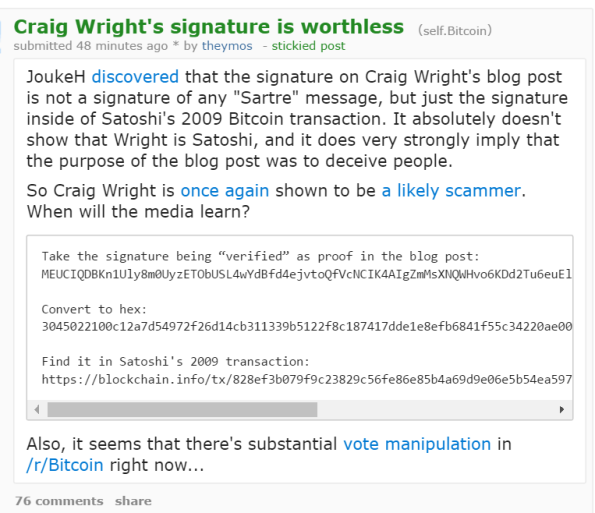SUMMARY:
- Yes, this is a scam. Not maybe. Not possibly.
- Wright is pretending he has Satoshi’s signature on Sartre’s writing. That would mean he has the private key, and is likely to be Satoshi. What he actually has is Satoshi’s signature on parts of the public Blockchain, which of course means he doesn’t need the private key and he doesn’t need to be Satoshi. He just needs to make you think Satoshi signed something else besides the Blockchain — like Sartre. He doesn’t publish Sartre. He publishes 14% of one document. He then shows you a hash that’s supposed to summarize the entire document. This is a lie. It’s a hash extracted from the Blockchain itself. Ryan Castellucci (my engineer at White Ops and master of Bitcoin Fu) put an extractor here. Of course the Blockchain is totally public and of course has signatures from Satoshi, so Wright being able to lift a signature from here isn’t surprising at all.
- He probably would have gotten away with it if the signature itself wasn’t googlable by Redditors.
- I think Gavin et al are victims of another scam, and Wright’s done classic misdirection by generating different scams for different audiences.
===
UPDATE: This signature does actually validate, you just have to use a different version of OpenSSL than I did originally.

Of course, if this is the signature that already went out with that block, it doesn’t matter. So I’m looking into that right now.
Update 2:
OK, yes, this is intentional scammery. This is the 2009 transaction. See this:

And then, that hex is of course this hex, as in the zip below:

Of course that’s exactly what Uptrenda on Reddit posted. Gotta give Wright very small props, that’s a mildly clever replay attack, foiled by total lack of QA.
====
So Craig Wright is claiming to be Satoshi, and importantly, Gavin Andreson believes him. I say importantly because normally I wouldn’t even give this document a second thought, it’s obviously scam style. But Gavin. Yet, the procedure that’s supposed to prove Dr. Wright is Satoshi is aggressively, almost-but-not-quite maliciously resistant to actual validation. OK, anyone can take screenshots of their terminal, but sha256sums of everything but the one file you actually would like a hash of? More importantly, lots of discussion of how cryptography works, but not why we should consider this particular public key interesting.
But it could actually be interesting. This public key claimed is indeed from a very early block, which was the constraint I myself declared.
But for those with an open mind, moving a few chunks of the so-called “bitcoin billion” should be proof enough, says Dan Kaminsky, a well-known security researcher with a history of bitcoin analysis. Even the theory that Wright might have somehow hacked Nakamoto’s computer hardly discounts that proof, Kaminsky argues. “Every computer can be hacked. But if he hacked Satoshi, then this guy knew who the real Satoshi was, and that’s more than what the rest of us can say,” Kaminsky points out. “If Wright does a transaction with one of these keys, he’s done something no other wannabe-Satoshi has done, and we should recognize that.”
OK, it’s not a key attached to the Bitcoin billion, but Block 9 is close enough for me. The bigger issue is that I can’t actually get the process to yield a valid signature. I’ve gone over the data a few times, and the signature isn’t actually validating. I’m not going to read too much into this because Dr. Wright didn’t actually post an OpenSSL version, and who knows if something changed. But it is important to realize — anyone can claim a public key, that’s why they’re called public keys. The signature actually does need to validate and I haven’t gotten it to work.
I could have missed something, it’s pretty late. So here’s the binary blobs — nobody should have to try to hand transcribe and validate hex like this. If I had to speculate, it’s just some serious fat fingering, where the signature is actually across some other message (like that Sartre text we see 14% of). Alternate explanations have to be … unlikely.
UPDATE:
*facepalm*

Source: DanKaminisky
Source Link: https://dankaminsky.com/2016/05/02/validating-satoshi-or-not/